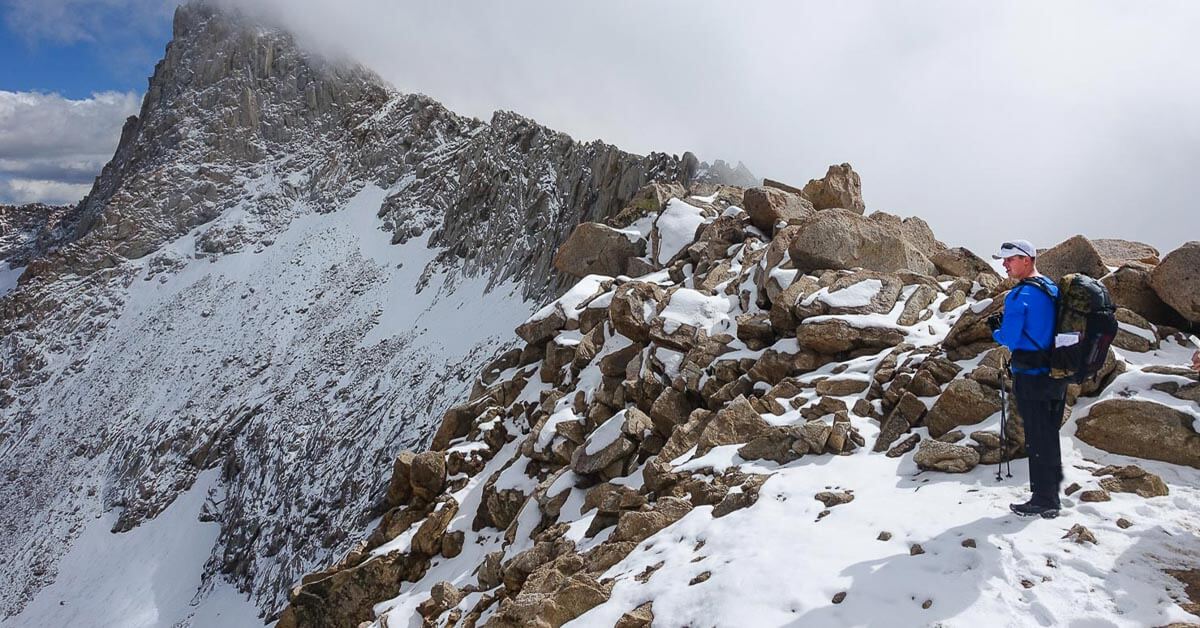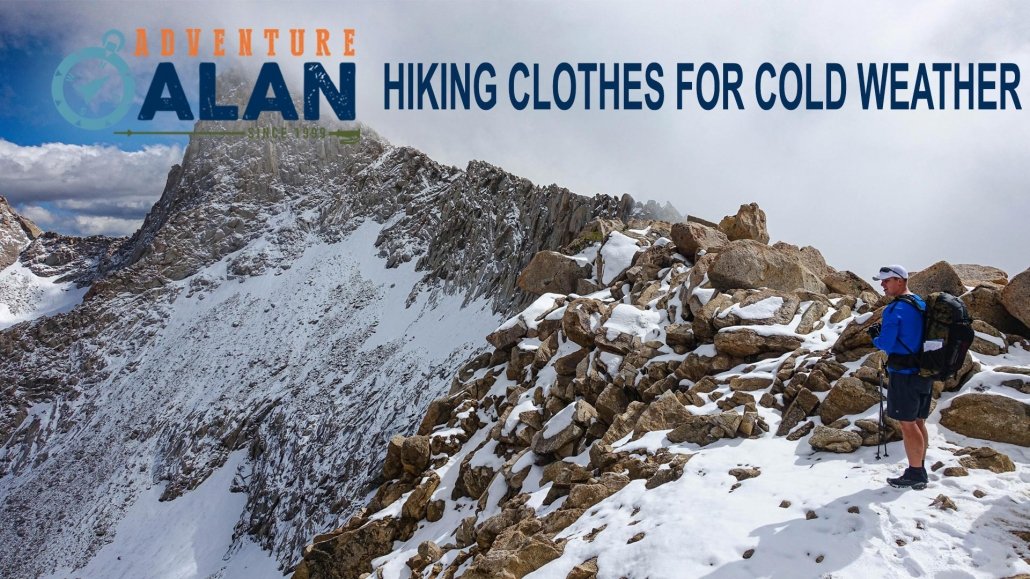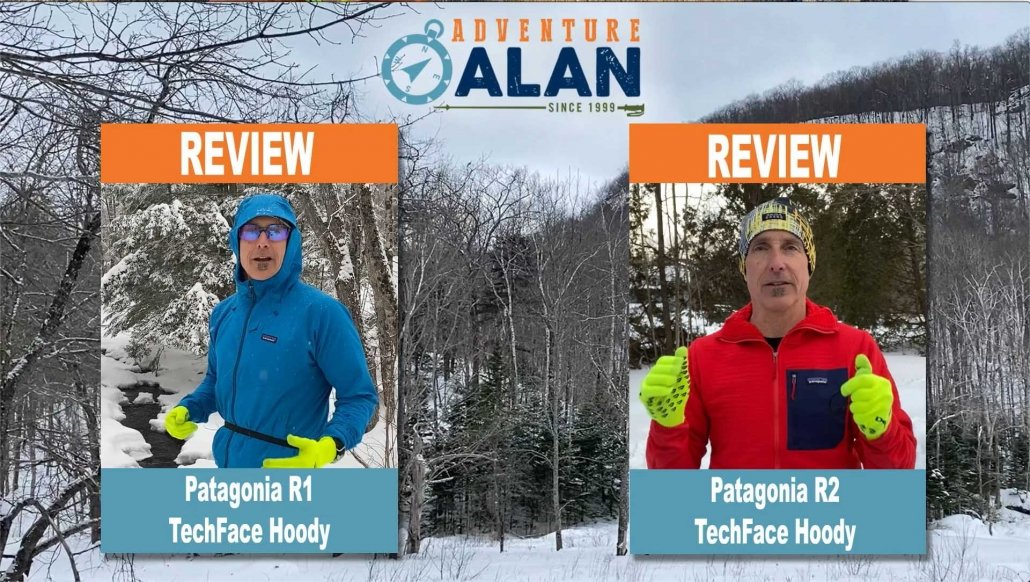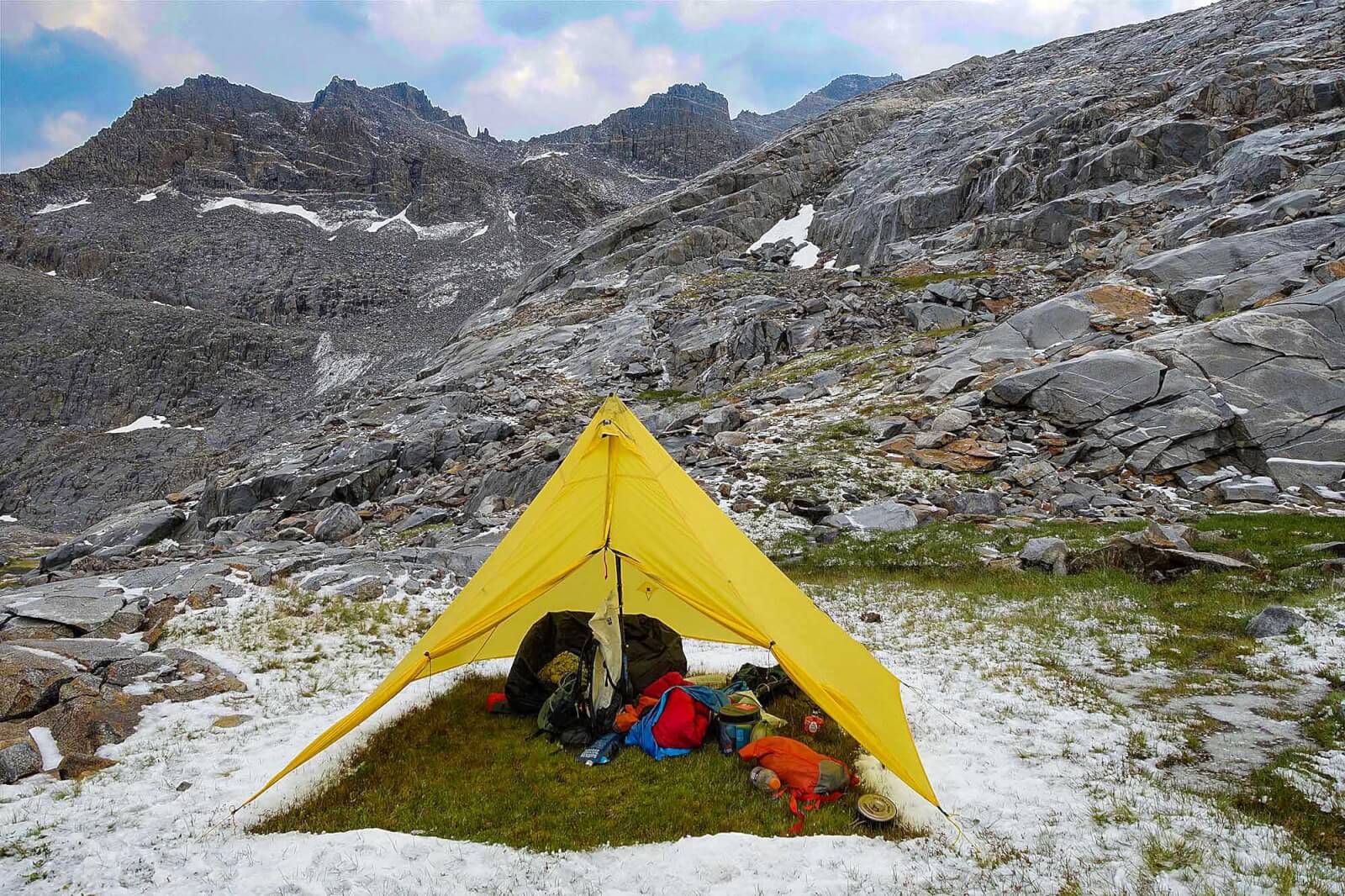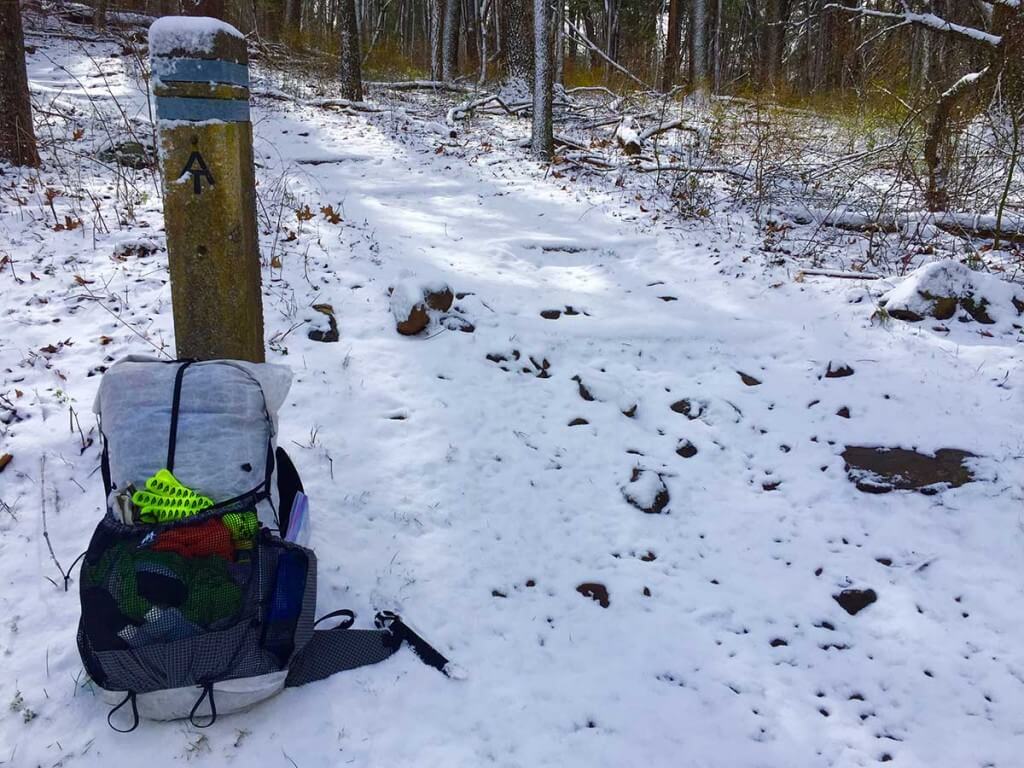Hiking Clothes
A Hiking Outfit to Stay Safe and Warm
Wearing the right hiking clothes will drastically improve your overall trip experience by making you comfier, faster, and especially safer. In combination with your technical outerwear & wearable accessories, these items form what’s known as the layering system. And that’s where we come in. We’re here to share 40 years of backcountry layering experience by identifying the best deals on the top performing hiking attire for the year, and sharing tips for how to make this system perform optimally for you.
No such thing as bad weather | Just inappropriate clothing
But first, exactly what is a clothing layering system and how does it protect you in challenging weather? In a nutshell, it is the sum total of all wearable items a hiker carries with them, and it can be defined by the range of temperatures and conditions it allows a person to safely hike and camp. Broadly speaking, a good layering system should be lightweight, affordable, and able to handle all “3 season” conditions. This means it will allow you to live outdoors in temperatures as low as the mid-twenties, through rain, sleet, and snow. The hiking clothes we highlight on this list will allow you to thrive in mountain ecosystems around the world, from Alaska to Patagonia and everything in between. Wherever we’re going, we use the same clothing as a baseline, and modify based on specific needs and conditions.
You make Adventure Alan & Co possible. When purchasing through links on our site, we may earn an affiliate commission at no additional cost to you. Here’s why you can trust us.
This Guide is in 6 Parts
- Top 6 Mistakes Layering Hiking Clothes “layering” as practiced most hikers it is flawed. It can be heavy, expensive & improperly used can even make you colder. Learn how to avoid these mistakes.
- List of Our Favorite Hiking Clothes including the “shoulder seasons” of late-Fall & early Spring
- The Essential Techniques to Use these Layering Systems how you use your clothing might be more important than what clothes you bring.
- Shoulder Season Gear Hacks Addendum Table. Non-clothing gear, like shelter and sleeping bag, to help you keep warm in colder shoulder season conditions.
- Is a Fleece Jacket is Better than a Windshirt?
- Key Hiking Clothing for Cold Weather some our favorite clothes to keep warm when the temperature drops, including the great Patagonia R1 TechFace Hoodie (also see full video review below).
Hiking Clothes Quick Picks
These are some our favorite clothes for hiking that we grab out of the closet for most trips.
REI Co-op Merino Midweight Half-Zip Base Layer
$62 to $90 at REI
Many folks like super soft, itch free merino wool for clothing. It feels less clammy than synthetics, still keeps you warm when wet, and it stenches far less than most synthetics — a big plus for long backpacking trips or travel where frequent washing many not be possible. This is our favorite and most versatile wool/poly blend baselayer that combines the best of both fabrics. It has a zip for temperature control and ventilation, thumb loops to keep your hands warm and for sun protection. Its ultra-breathable mesh panels deliver cooling airflow in key areas. Finally, it has just the right amount of warmth for most of the year but we’ve also used it with great success in the deserts of Utah.
Our favorite shirt is the REI Co-op Merino Midweight Half-Zip Shirt. In this chilly weather we use it our “hiking shirt” and baselayer. This saves weight and and the complications taking on and off your baselayer. The half-zip regulates temperature and the long sleeves and full neck are good for sun protection. Wool is warm when wet, does a good job of wicking moisture away from your skin and is naturally antimicrobial so it dramatically reduces stench. Finally soft merino wool does not itch. We also like the similar Smartwool Merino 250 Base Layer Quarter-Zip. And For those who can’t handle wool look at $45 REI 1/2-Zip Active Shirt.
The North Face TKA 100 Glacier 1/4 Zip
$35 to $58 at Amazon
A 100 wt fleece shirt is our go to favorite mid-layer—goes on every trip! Sadly it appears that 100 wt fleece shirts like this are a becoming scarce so it’s best to buy one now! As of writing, there is a decent but diminishing inventory of the xcellent. The North Face Men’s TKA 100 Glacier Quarter Zip on Amazon.
This is a lightweight, inexpensive fleece that blocks the wind reasonably well. With an appropriate layering scheme, this can replace the need for a wind jacket for me entirely! I find that in cool weather (where a layering system is most useful) a fleece shirt is better. For almost the same weight of a windshirt (8oz), a light 100 weight fleece shirt has a greater temperature range for comfort — which means fewer clothing changes. And a thin fleece doesn’t trap moisture in the same way as windshirt.
Note: this only comes in a Men’s/Unisex version but Alison has happily used one for years and loves it.
2020 Outdoor Research Helium Rain Jacket
$110 to 159 at REI
A light and compact rain jacket is key to staying warm and dry in intermittent rain. A small compact one that can fit into the side pocket of your pack or even your pants pocket is key to quickly getting it on and off quickly. That way you can put it on quickly to stay dry and take it off and stow it quickly to keep from sweating out when the rain stops.
The new 2020 Outdoor Research Helium Rain Jacket is a great value! And for 2020 it’s way more durable at the same weight! The first upgrade to the highly regarded Outdoor Research Helium Rain Jacket in 8 years! It boasts a new super strong Pertex Diamond Fuse fabric. Outdoor Research say it 5x more tear resistant and 2x more abrasion resistant than the old Helium. That’s a huge deal for a 6 oz Rain Jacket where any increase in durability is most welcome. In addition for 2020 it got a slightly roomier fit. While it weighs far less than just a few rain jackets, it still has a good feature set — drawcord adjustable hood, elastic adjustable cuffs, and a chest pocket that can stow the entire jacket. While a bit larger for 2020 this jacket this jacket is still trim. It will layer over an 8-12+ oz fleece midlayer, but anyone layering it over something larger (e.g. a down jacket) should likely size up. And like always, the 2020 Outdoor Research Helium Rain Jacket costs less than competitor’s 6 ounce rain jackets!
The matching Outdoor Research Helium Rain Pants share the same strong Pertex Diamond Fuse material, where its durability may be even more welcome as pants often take more abuse than jackets. They also have lace loops to attach to your shoes which turn the pants into a semi-gaiter.
Our Favorite Hiking Clothes
A Complete Hiking Outfit
The hiking clothes in this post are our top choices for 3-season conditions (spring, summer, and fall) and for temperatures from the mid-20s °F and up. This clothing has withstood the test of time (some items for over a decade) in all sorts of challenging weather in the US and on 3 continents. And with surprisingly little variation our hiking clothes has worked exceptionally well from the high mountains of Alaska, to Patagonia, to the desert and even the jungles of South America.
Note: Much of this clothing is from our top-ranked Ultralight Backpacking Gear List | 9 Pound. Take a peek at it for an integrated set of gear that won’t weigh you down and break your back.
| CLothing | Item | Oz | Comments |
|---|
| Shirt and Baselayer | $45 REI 1/2-Zip Active Shirt 6.5 oz or Smartwool Merino Quarter-Zip 8.8 oz | Neck zipper key to warmth management |
| Shirt and Baselayer (for cold Wx) | Patagonia R1 Hoodie | 12.5 | Think of it as “fur for humans.” possibly the most versatile cold to very cold weather base layer. It works over an astonishing range of conditions. |
| Mid-layer top | The North Face Men’s TKA 100 Glacier Quarter Zip | 7.9 | Sadly it appears that 100 wt fleece shirts like this are a dying breed. You may still be able to find a few. Otherwise go for a 200 wt one, the The Patagonia R1 TechFace Hoody (currently our favorite cold Wx garment) |
| Rain Jacket | 2020 Outdoor Research Helium Rain Jacket | 6.3 | Light rain-jacket is just as dry as a heavy one (Use as “windshirt” only when very cold) | also |
| Rain Jacket, 3-layer tech (for cold Wx) | REI Co-op Drypoint GTX Jacket | 10.9 | Given that I will likely be wearing my jacket more frequently (both for rain and as a “windshirt” when cold), I favor a more breathable & durable 3-layer construction for shoulder season (SS). |
| Rain Pants (bring them!) | Outdoor Research Helium Rain Pants 6 oz or 2020 Enlightened Equipment Visp Rain Pants 4oz (super light and breathable) | While we might not bring them on all 2+ season trips, we DO bring rain pants in the shoulder season |
| For more rainwear see: Best Lightweight Rain Jackets |
| Warm jacket | REI 650 Down Jacket – great value | 10.5 | For occasional rest stops. Moderate/consistent movement is key to keeping warm when it’s cold |
| For down jacket options see: Guide to Lightweight Down Jackets and Pants for Backpacking |
| Pants | REI Sahara Pants | 14 | Ex Officio and many others make similar pants |
| Down pants (for cold Wx) | West. Mtn. Flash Pants (6.5) or Montbell Superior Down Pants 8.4 or FF Heilos Down Pants (13) | 6.5 | For colder weather. West. Mtn. pants light & warm! Montbell’s a great value in down pants. Helios crazy warm with side zips. |
| Underwear | ExOfficio Give-N-Go | 2.0 | Dry fast, will rinse/wash most days |
| Gloves | Defeet DuraGloves (2.5) | 2.5 | Great liner glove. Light, warm, durable! (or similar) |
| Rain Mitts (bring them!) | MLD eVENT Rain Mitts (1.2) | 1.2 | Critical for keeping hands warm and dry in cold rain. Also work as great wind shells. |
| Gloves (for cold Wx) | RBH Designs Vapor Mitt | 9.0 | My goto insulated mitts (I have a 4oz UL Version) |
| Gloves – cold & wet conditions | Showa Japanese fishing gloves | 4.5 | Alternative hand-wear for wet & cold. Waterproof, breathable, with grippy rubber-like shell. |
| Shoes | Altra Lone Peak Trail-Running or Brooks Cascadia Trail-Runners | 18 | Altra: Light, huge toe room, super comfortable. Brooks: tried and true trail favorite. |
| Socks | SmartWool PhD Light Mini or Darn Tough 1/4 UL w cushion | 1.8 | Key to keeping feet warm is to keep moving and NOT warmer socks |
| Camp footwear | Feathered Friends Down Booties | For those with cold feet. Put on with dry socks as soon as you get into camp! |
| Warm hat | Warm watch cap/beanie (REI) or OR Option Balaclava (1.8) | 1.8 | Also note that a hooded down jacket is HIGHLY DESIRABLE. And the built in hood on the Patagonia R1 Hoodie is excellent |
| Cold hands and feet | Chemical hand warmer and foot warmer packets | Critical re-warming contingency/backup for hands and feet in case you blow it and get them too cold to warm up again on their own. |
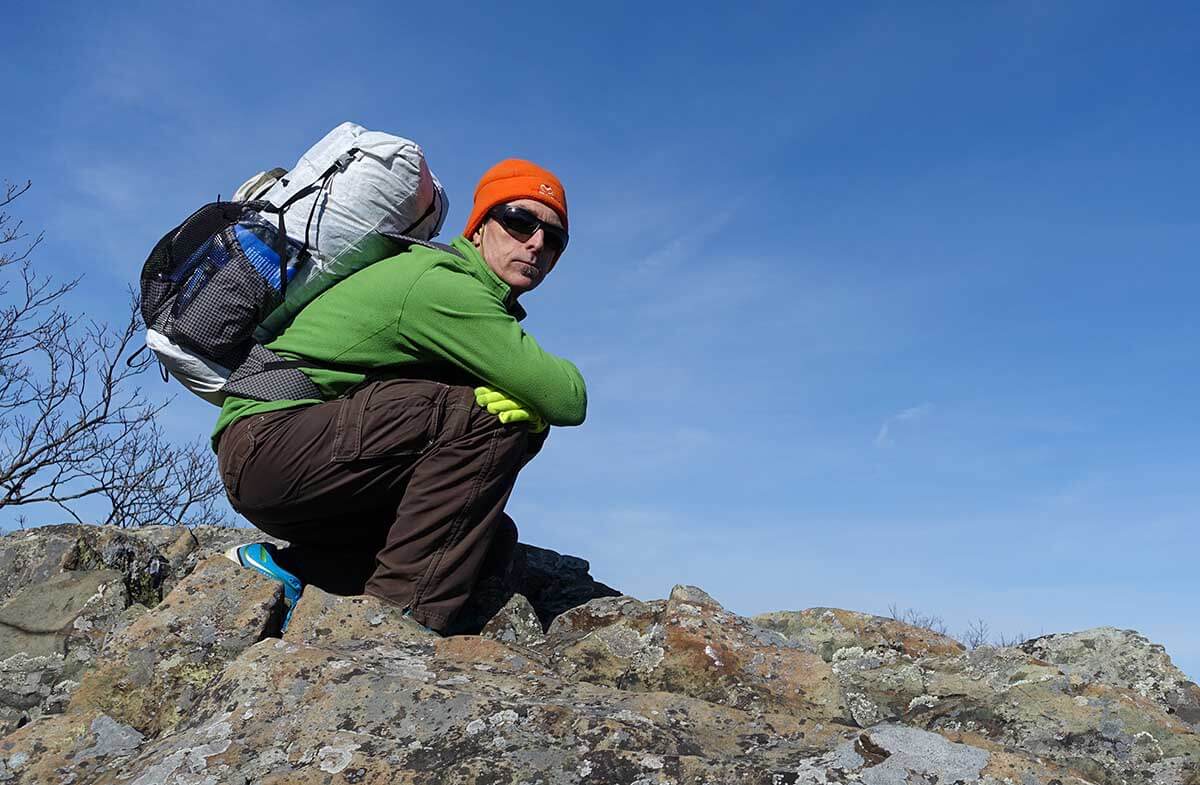
A single set of clothes for the entire day: Here I am in late winter conditions at around 4,000 ft on the Appalachian Trail. It’s windy and about 25 degrees. But I’m warm and comfortable hiking at my own pace wearing just a 6 oz base layer, a 7 oz fleece shirt (mid-layer) , a 2 oz fleece hat, and 2 oz gloves. I can hike in this outfit from the mid-20s °F to around 50 °F – going up and down hill without needing to stop for a clothing change.
Top 6 Mistakes Layering Hiking Clothes
The “layering system” for hiking clothes sounds attractive in theory. But as practiced by most hikers it is seriously flawed. It can be heavy, and expensive. And improperly layering hiking clothes could even make you colder. This article points out the major mistakes hikers make when buying hiking clothing and layering them. And of course, it has tips on how to properly select and use a better and lighter set of hiking clothes. I can even save you money with your hiking outfit!
- People bring too many layers as well as the wrong layers. This costs a lot of money and it’s heavy. Try to find a minimal set of light clothing that will work in a broad range of conditions. It can be done!
- A good layering system is NOT about frequently changing layers. Quite the opposite, you should strive to minimize adding or removing layers! A single set of well-selected clothes should work in a broad range of temperatures (e.g. from mid-20s °F to around 50 °F) without adding or removing layers.
- Keep Hiking When It’s Cold. Frequent stops to change layers can seriously chill you. And once chilled it can be exceptionally hard to get warm again. (In cold weather, constant but moderate movement is what keeps you warm.) Minimize stops to essential needs, and don’t make them longer than necessary. If you really need to stop for a longer time (over 5 minutes), try to do it in a warmer, more protected area and put on warm clothing (e.g. down jacket) as soon as you stop. Take your warm clothing off just before you start hiking again. Or even after you been walking for a few minutes.
- Overheating and sweating out clothes will get you very cold in the long run. Wet clothing is cold clothing and unhappiness. (And in cold weather it takes a very long time to dry, if ever.)
- A windshirt is not all that it’s cracked up to be. An inexpensive, midweight fleece jacket or (Patagonia R1 Hoodie) is far more useful cool weather and saves weight. (Among other things, it helps minimize sweating out your clothes!)
- Finally, leave your shorts and short sleeved shirts at home. Long pants and long sleeved shirts are far better and more practical at protecting you from brush, sun, and disease carrying insects than sunscreen and insect repellents.
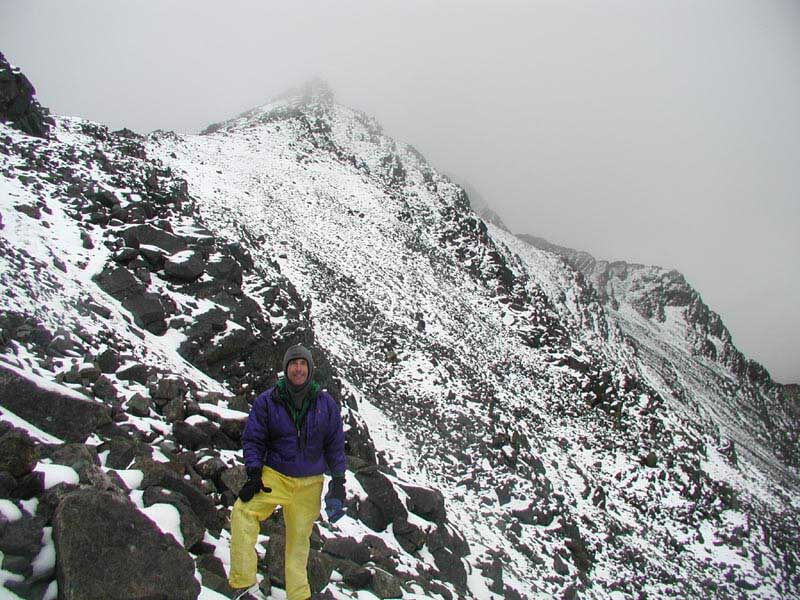
A light layering system while summiting in Scotland’s Highlands. I was ribbed by the Scots as “the Yank in trainers [running shoes] and yellow pants” for wearing virtually nothing given the winter conditions. Nonetheless, I summited just fine in my light running shoes and 4 oz shell pants—wearing the same clothing system without changes to the summit and back down.
Essential Techniques for Using Hiking Clothes
A layering system is really just a set of good hiking clothes. It is supposed to keep you safe and comfortable in a broad range of temperatures and environmental conditions (wind, rain, sleet and snow). The layering system is most useful in cool to cold weather (in warm weather, a light top and bottom usually suffice). Ideally, this layering system should be simple, light and inexpensive.
In cold weather the challenges to staying warm and dry are to
- Not freeze when hiking in low temperatures and/or at low physical exertion levels (e.g. walking downhill)
- But also not overheat and soak your clothing with sweat as temperatures get warmer and/or at high physical exertion levels (e.g. hiking uphill with a pack on)
- To protect you from wind and precipitation
- Finally, have a very warm layer ready (usually a down jacket) to keep warm at rest stops and in camp
Three Essential Techniques for Hiking in Cold & Wet Conditions
1. Keep Hiking When It’s Cold | Avoid stops and/or keep them short
In colder weather, you can spend far too much time stopping to adjust layers. This is especially true on hilly trails where you are consistently getting sweaty and hot going uphill, and freezing while on ridges and going downhill. Moderate but consistent movement, not stopping for layer changes, is the key to keeping warm when it’s cold.
- Hiking to keep warm needn’t be at all tiring or strenuous.
- Even walking 1 to 1.5 miles per hour should keep your internal, metabolic heater going, and keep your hands and feet warm. If you are getting tired you are going too fast!
- Minimize stops to essential needs, and don’t make them longer than necessary. When you stop, you get cold quickly and it takes a long time to warm up again. If you’re starting to chill it’s time to move.
- If you really need to stop for a longer time (over 5 minutes), try to do it in a warmer, more protected area and put on warm clothing (e.g. a high quality down jacket) as soon as you stop. Take your warm clothing off just before you start hiking again. Or after you have been walking for a few minutes. (note: I store the jacket as the topmost item in the main bag of my backpack so I can quickly retrieve it and put it back.)
2. Clothing Adjustments
- When starting to hike, I put on just enough clothing to keep me warm when moving. (It might take 5-10 minutes at a brisk pace to get fully warm. Then I can back-off to my normal hiking pace.)
- Overdressing, getting hot and then sweating out is a great way to get wet and then really cold. It’s very easy to get clothing wet, but it takes a long time to dry it out in cold and damp weather. Wet clothing is cold clothing and unhappiness. [Note this is where the better venting fleece jacket outshines a windshirt, allowing sweat to pass through your clothing and evaporate!]
- Temperature adjustments are made without stopping or changing a top or bottom layer. Too hot? take off hat and gloves (put in pants pockets). To further cool unzip fleece jacket and/or your base layer, and possibly push sleeves up. Too cold? reverse the procedure.
- I only add warmer clothing when I can no longer stay warm walking at a comfortable pace (and with a good clothing system, this is a rare).
- If you do need to change layers do it quickly. What most people don’t realize is how much time it takes to stop, take your pack off, put-on or take-off a layer, put your pack back on and start hiking again. It’s plenty long enough seriously to chill!
- If it’s extremely cold and windy, I will use my rain jacket as a windshell (note: unzipping your rain jacket all the way is a major cooling force when needed).
3. Keep your Clothing Dry
- At the risk of pointing out the obvious, put on your rainwear before you get wet. Have your rainwear readily available on the outside of your pack so you can put it on quickly and without opening your main pack bag and exposing your pack contents to rain. (I like to keep it in the large rear pocket.)
- When wearing your rain jacket pay special attention to not sweating out your clothing. Adjust and ventilate your clothing and/or slow your hiking pace as necessary. As above, it’s very easy to get clothing wet, but it takes a long time to dry it out in cold and damp weather.
- And if it’s going to rain for a long time you are going to get wet—it’s inevitable one way or the other. Just try to do your best to keep warm and minimize it. [A discussion on how to deal with long periods of rain (like days), is another whole topic and beyond the scope of this post.]
Shoulder Season Gear Hacks Addendum
The following is excerpted from Why You Won’t Freeze or Starve Ultralight Backpacking. This gear (in combination with the clothing above) will keep you warm and protected with a minimal increase in weight over 2+ season gear.
- Your tent doesn’t keep you warm. The hard reality is that the temperature inside your tent, at best, will only be a few degrees warmer than the outside temperature.
- Your tent just keeps the wind and rain off (very important!)—but so will a tarp or pyramid shelter.
- What does keep you warm is a puffy down sleeping bag and jacket. Usually used in combo when it’s super cold. That is, down get you the most warmth for its weight.
- So get a good down jacket and a down sleeping bag or quilt vs. spending extra bucks and weight on a bomber shelter. That is the difference in weight between a 14 oz pyramid shelter and a 3+ pound tent will get you some incredible warmth in down gear and clothing!
- Don’t believe the dire warnings about getting down wet—it’s hard to do. In over 40 years of backpacking all over the world in all sorts of conditions, I have yet to get my down so wet that it didn’t keep me warm. (New water resistant shell fabrics and water resistant down only improve upon this.)
| Tent | See our Best Backpacking Tents for 2020 | Lightweight & Ultralight 2 to 3 pounds| Pick a light one! | |||
| Pyramid Tent | Mountain Laurel Des. Solomid XL or HMG Ultamid 2 Pyramid Shelter | Compared to a traditional tent, a Pyramid tent is light, strong, and able to withstand rain, snow and high winds at a fraction of the weight. Super easy to set up (faster than many tents!). | |||
| For more on Tents see: Best Backpacking Tents | Lightweight & Ultralight | |||
| Sleeping Bag (a warm one!) | REI Co-op Magma 15 Bag 32 oz | (Tested comfort 28 degrees (F) | A bag rated approximately +20 is best for the shoulder season. Consider using it in conjunction with a warm down jacket to increase its temperature range. | |||
| Sleeping Quilt | Enlightened Equipment Quilt +10 25 oz | Comfort range ~+10F! |Insane warm and a Great value! ~1/2 cost of sleeping bag and significantly lighter. | |||
| For more on Sleeping bags and Quilts see: The Art of Sleeping Warm – A Guide to Sleeping Bags and Quilts | |||
| Sleeping Pad (warm one!) | Therm-a-Rest NeoAir XTherm 15 oz XTherm, R6.9. [Alternate pad: “Women’s” R5.4 pad 12 oz is lighter/warmer than Men’s. Best for for many men too!] A Hack: For a light, low cost hack cut Therm-a-Rest RidgeRest pad in half & put it over the top of your current pad (shoulder to knees) to increase its warmth +R2.0. | |||
Is a Fleece Jacket is Better than a Windshirt?
We find that in cool weather (where a layering system is most useful) a fleece shirt is better. A light 100 weight fleece shirt has (or even better the new The Patagonia R1 TechFace Hoody described in the next section) has a greater temperature range for comfort. This means fewer clothing changes which will keep you warmer. And a thin fleece doesn’t trap moisture in the same way as windshirt.
Yes, against common perception, windshirts are not all that “breathable!” Try running on a warm day in a T-shirt and then in a T-shirt with a windshirt over it if you don’t believe this. (Note: many cheap fleece jackets in the $20 range may work fine.)
- A light 100 or 200 weight fleece shirt or jacket is far warmer than a windshirt and more versatile It is an excellent insulating mid-layer, and it does a surprisingly good job of slowing down the wind. (Sadly many major brands are discontinuing their 100 wt fleece shirts. You may need to make due with 200 wt/mid-wight fleece OR buy a thinner “cheap” fleece at stores like Target. Oh, and the Patagonia R1 Hoodie is still a great option albeit a bit pricy.)
- Note: this is for inexpensive fleece that has a much tighter weave and is far more wind resistant than more open weave, high tech fleece like Patagonia R2. As such, the fleece does an a decent job keeping wind from penetrating your clothing. BUT it is far less clammy and more breathable than a windshirt, allowing sweat to pass through your clothing and evaporate.
- By the time it’s cold enough and windy enough to warrant a fully windproof shell like a windshirt, my rain jacket does fine. By then it’s cold enough that condensation from the rain jacket is not a huge issue.
- Finally, it’s lighter. Since you’d bring a fleece layer anyway, you save the weight of a windshirt and simplify your layering system.
- That being said, a good windshirt is only 3 ounces, so bring one if you want! (We just find that We end up in a taking it on and off scenario to control heat and prevent sweating out. And this ends up with extra stops and lost time.)
Key Hiking Clothing for Cold Weather
These are some our favorite clothes to keep warm when the temperature drops. Key performance for these top garments is that the breathe well enough to keep your from getting all sweaty — that is you won’t get wet from sweat and then freeze — but they block enough wind to keep you warm.
Key Gear Highlight
Patagonia R1 TechFace Hoodie
$179 at REI
The Patagonia R1 TechFace Hoody is our favorite active top in cold weather. it works in a broader range of conditions than any single piece of cold weather we know of. It’s something like magic, working for us as both as a mid-layer and wind and weather resistant outer shell a the same time. As such, it It keeps us warm and dry in a broad range of conditions in cold weather from the mid-20º F and up. It has the perfect blend of warmth, breathability and weather resistance. Compared to plain R1 Hoodie, the new TechFace Fabric is more wind and abrasion resistant and the durable water repellent (DWR) finish and tighter weave on face fabric helps shed moisture from snow and light rain. Downside is that it is heavier than the plain R1 hoodie.
Note: our favorite cold weather top clothing system is a R1 TechFace Hoodie layered over a merino wool T-shirt like the REI Co-op Merino Midweight Base Layer Crew Top.
Patagonia R1 Hoodie
$109 to $169 at REI
Think of it as “fur for humans.” The Patagonia R1 Hoodie the warmest, comfiest baselayer (or light mid-layer) and it works in an amazing range of conditions. It breathes well, stretches comfortably, and has a long cut to keep your heat trapped in. The arms are long with thumb holes to keep heat from leaving through the common wrist gap, and the hood fits well, and zips up with a full mouth cover, trapping all your heat inside, and piping warm air from your core to your head. Of course, it comes in Men’s and Women’s versions. While warm enough for winter, it works in one of the broadest ranges of temperatures of any baselayer!
Patagonia Nano-Air Insulated Hoodie
$299 at REI Currently Out of Stock most places
Stay warm and don’t sweat out and freeze with this innovative jacket. Admittedly expensive, this is one of the most versatile cold weather garments for active people! The new highly breathable insulation garments like the Patagonia Nano-Air Insulated Hoodie or Patagonia Nano-Air Light Hybrid Insulated Jacket are a huge stride forward in staying warm but not sweating out for active pursuits like backpacking uphill, and fast hiking. Their exceptionally breathable fabric has tons of air permeability/ventilation (put your mouth on the fabric and you can easily breathe through it) yet provides just enough wind blocking to keep you warm. This is far better than the old school fleece + shirt combo which is not breathable enough to keep you from sweating out.

